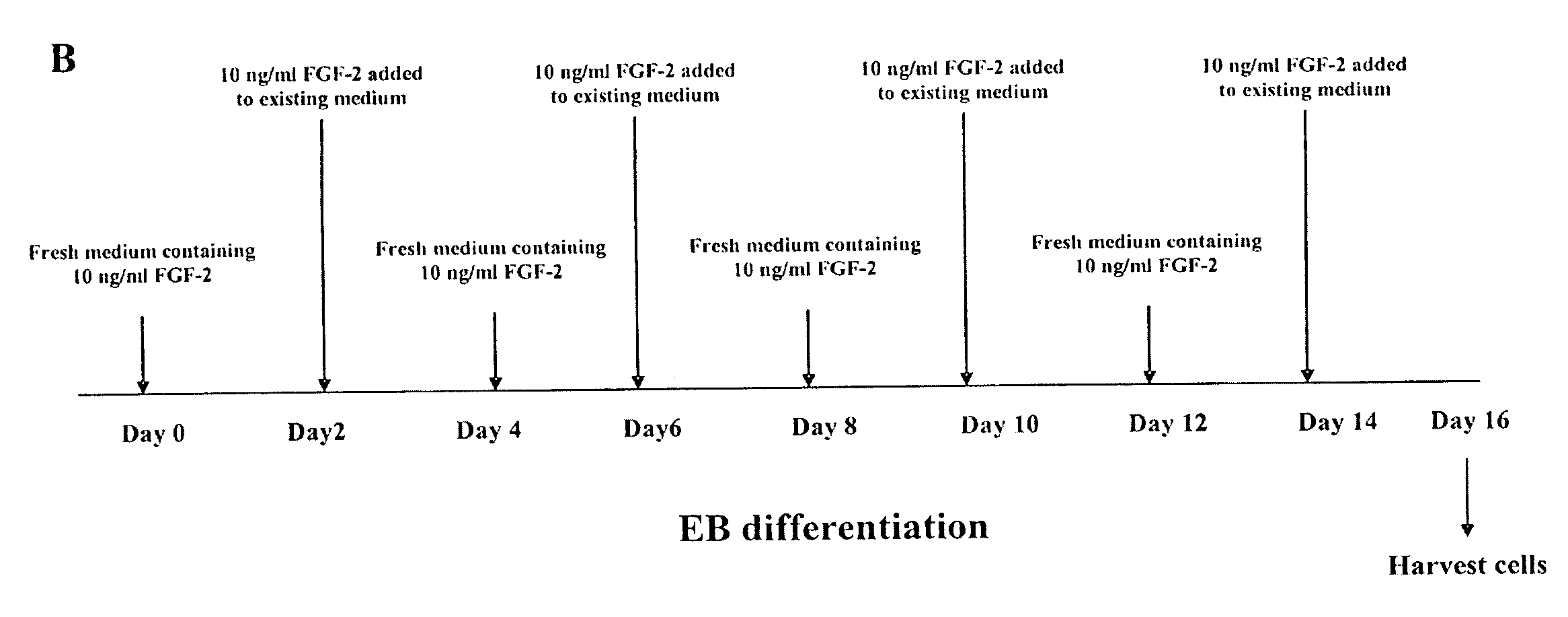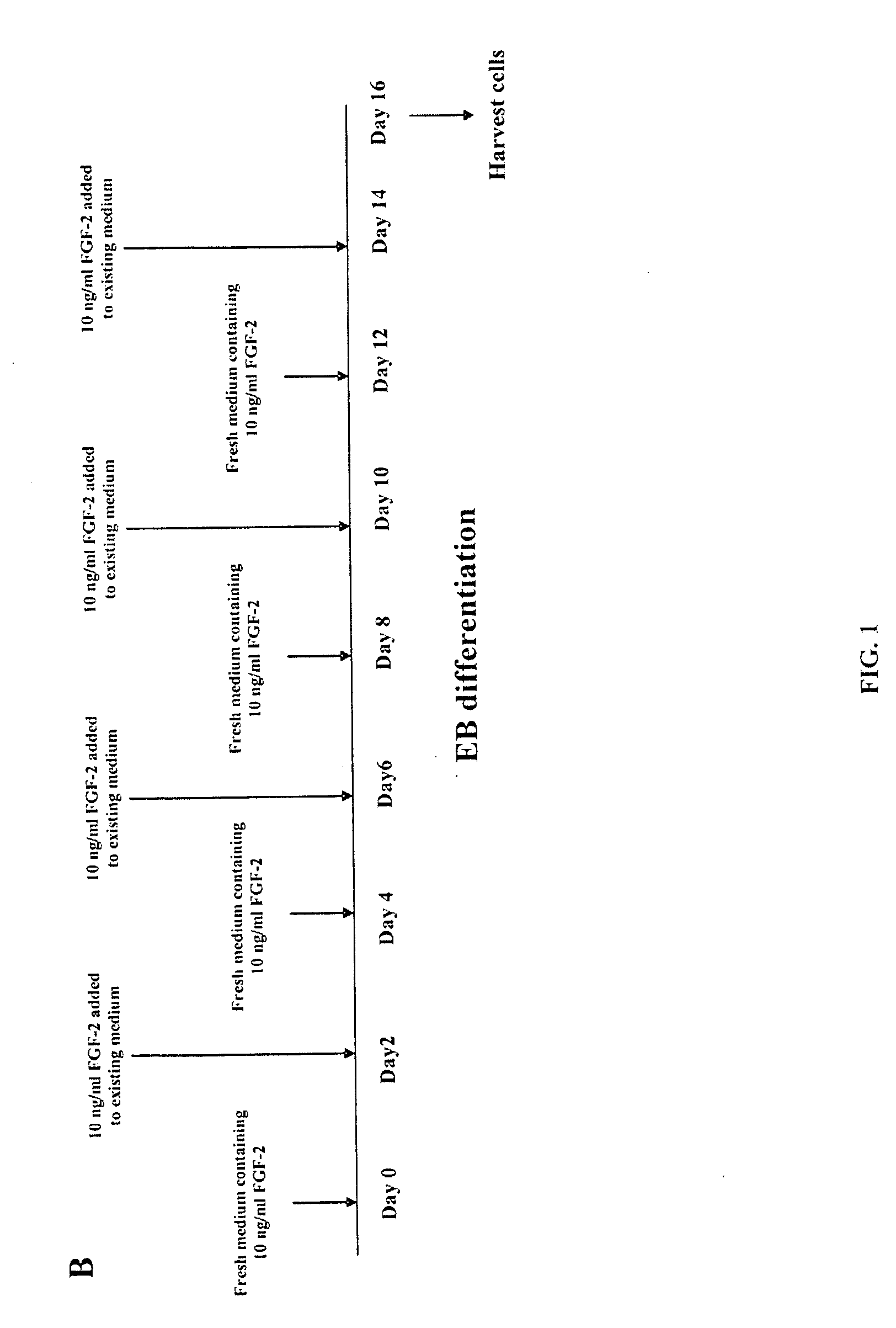In vitro differentiation of hematopoietic cells from primate embryonic stem cells
a technology of embryonic stem cells and hematopoietic cells, which is applied in the field of in vitro differentiation of hematopoietic cells from primate embryonic stem cells, can solve the problems of failure to form colonies in a standard methylcellulose assay, inability and inability to understand the steps required to obtain hematopoietic precursor cells from such cells
- Summary
- Abstract
- Description
- Claims
- Application Information
AI Technical Summary
Benefits of technology
Problems solved by technology
Method used
Image
Examples
example 1
Differential Requirements for Hematopoietic Commitment Between hESCs and rESCs
[0045]Methods:
[0046]Embryonic Stem Cells: (1). hESCs. An undifferentiated hESC cell line, H9 (WiCell Research Institute; Madison, Wis.), was maintained by co-culture with irradiated murine embryonic fibroblasts (MEFs) in DMEM / F12 (Invitrogen; Carlsbad, Calif.) supplemented with 20% FBS (Invitrogen), 1% nonessential amino acids (NEAA; Invitrogen), 1 mM L-glutaimine (Invitrogen), 0.1 mM β-mercaptoethanol (Sigma; St Louis, Mo.) and 4 ng / ml human FGF-2 (R&D Systems, Inc.; Minneapolis, Minn.), as described by Thomson et al. Thomson J, et al., “Embryonic stem cell lines derived from human blastocysts,” Science 282:1145-1147 (1998), incorporated herein by reference as if set forth in its entirety; see also Amit M, et al., “Clonally derived human embryonic stem cell lines maintain pluripotency and proliferative potential for prolonged periods of culture,” Dev. Biol. 227:271-278 (2000).
[0047](2). rESCs. R366.4, R42...
example 3
Role of FGF-2 in Hematopoietic Differentiation of rESCs
[0080]Methods:
[0081]ESCs: hESCs (i.e., H9) and rESCs (i.e., R420, R456 and ORMES-7) cell lines are described above and were maintained by co-culture with irradiated MEFs in DMEM supplemented with 15% FBS (Hyclone), 1 mM glutamine, 0.1 mM β-mercaptoethanol and 1% NEAA. The cell lines were adapted to feeder-free culture by allowing them to expand on Matrigel®-coated plates, as previously described, with 4 ng / ml FGF-2. Rajesh D, et al., “Differential requirements for hematopoietic commitment between human and rhesus embryonic stem cells,” Stein Cells 25:490-499 (2007); and Xu R, et al., “Basic FGF and suppression of BMP signaling sustain undifferentiated proliferation of human ES cells,” Nat. Methods 2:185-190 (2005), each of which is incorporated herein by reference as if set forth in its entirety.
[0082]EB Culture: The EB culture conditions and methods are described above. Briefly, undifferentiated ESCs were harvested at confluenc...
PUM
| Property | Measurement | Unit |
|---|---|---|
| concentration | aaaaa | aaaaa |
| concentration | aaaaa | aaaaa |
| concentration | aaaaa | aaaaa |
Abstract
Description
Claims
Application Information
 Login to View More
Login to View More - R&D
- Intellectual Property
- Life Sciences
- Materials
- Tech Scout
- Unparalleled Data Quality
- Higher Quality Content
- 60% Fewer Hallucinations
Browse by: Latest US Patents, China's latest patents, Technical Efficacy Thesaurus, Application Domain, Technology Topic, Popular Technical Reports.
© 2025 PatSnap. All rights reserved.Legal|Privacy policy|Modern Slavery Act Transparency Statement|Sitemap|About US| Contact US: help@patsnap.com


